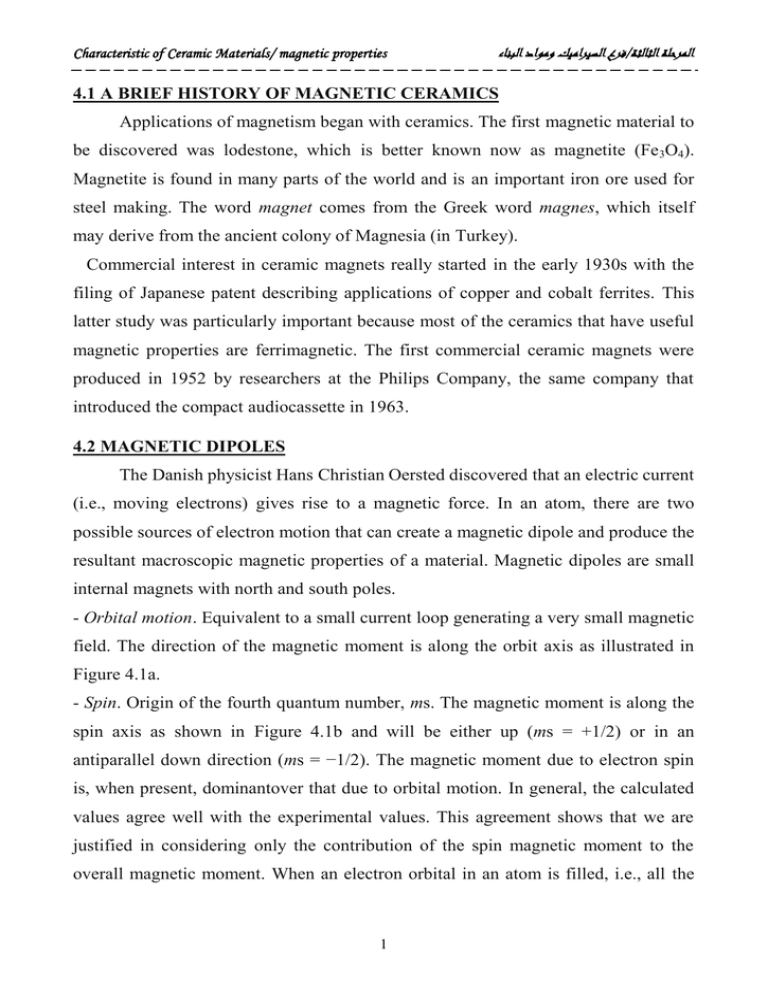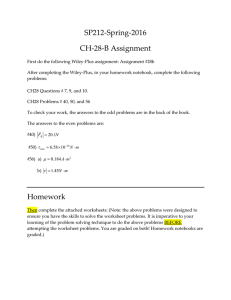4.1 A BRIEF HISTORY OF MAGNETIC CERAMICS
advertisement

Characteristic of Ceramic Materials/ magnetic properties فرع السيراميك ومواد البناء/المرحلة الثالثة 4.1 A BRIEF HISTORY OF MAGNETIC CERAMICS Applications of magnetism began with ceramics. The first magnetic material to be discovered was lodestone, which is better known now as magnetite (Fe3O4). Magnetite is found in many parts of the world and is an important iron ore used for steel making. The word magnet comes from the Greek word magnes, which itself may derive from the ancient colony of Magnesia (in Turkey). Commercial interest in ceramic magnets really started in the early 1930s with the filing of Japanese patent describing applications of copper and cobalt ferrites. This latter study was particularly important because most of the ceramics that have useful magnetic properties are ferrimagnetic. The first commercial ceramic magnets were produced in 1952 by researchers at the Philips Company, the same company that introduced the compact audiocassette in 1963. 4.2 MAGNETIC DIPOLES The Danish physicist Hans Christian Oersted discovered that an electric current (i.e., moving electrons) gives rise to a magnetic force. In an atom, there are two possible sources of electron motion that can create a magnetic dipole and produce the resultant macroscopic magnetic properties of a material. Magnetic dipoles are small internal magnets with north and south poles. - Orbital motion. Equivalent to a small current loop generating a very small magnetic field. The direction of the magnetic moment is along the orbit axis as illustrated in Figure 4.1a. - Spin. Origin of the fourth quantum number, ms. The magnetic moment is along the spin axis as shown in Figure 4.1b and will be either up (ms = +1/2) or in an antiparallel down direction (ms = −1/2). The magnetic moment due to electron spin is, when present, dominantover that due to orbital motion. In general, the calculated values agree well with the experimental values. This agreement shows that we are justified in considering only the contribution of the spin magnetic moment to the overall magnetic moment. When an electron orbital in an atom is filled, i.e., all the 1 Characteristic of Ceramic Materials/ magnetic properties فرع السيراميك ومواد البناء/المرحلة الثالثة electrons are paired up, both the orbital magnetic moment and the spin magnetic moment are zero. ●MAGNETIC MOMENTS The fundamental magnetic moment is the Bohr magneton, μB, which has a value of 9.27 × 10−24 A.m2. The orbital magnetic moment, μorb, of a single electron is (1) l is the orbital shape quantum number. The spin magnetic moment of an electron is (2) In ceramics where the magnetic behavior is due to the presence of transition metal ions with unpaired electron spins in the 3d orbital the magnetic moment of the ion due to electron spin, μion, is μ (3) FIGURE 4.1 Generation of atomic magnetic moments by (a) electron orbital motion around the nucleus; (b) electron spin around its axis of rotation. TABLE 4.1 Terms and Units Used in Magnetism 2 Characteristic of Ceramic Materials/ magnetic properties فرع السيراميك ومواد البناء/المرحلة الثالثة 4.3 THE BASIC EQUATIONS, THE WORDS, AND THE UNITS Table 4.1 lists the important parameters used in this chapter and their units. The situation regarding units is more complicated for magnetism than for almost any other property. The reason is that some of the older units, in particular the oersted (Oe) and the gauss (G), are still in widespread use despite being superceded, in the SI system, by A/m and T, respectively. The properties of most interest to us in the description of magnetic behavior are (μ, χ). These terms are, of course, related to each other and by considering the role of H to macroscopic measures such as M and B. The usual starting point to arrive at expressions for μ and χ is to consider a coil of wire in a vacuum as illustrated in Figure 4.2a. A current, I, passed through the wire generates a magnetic field H H= IN (4.1) where N is the number of turns of wire per meter. The magnetic induction or magnetic flux density, B, is related to H by B= μ0H (4.2) μo is a universal constant. When a material is placed inside the coil, as shown in Figure 4.2b, it becomes“magnetized.” The magnetic moment produced in the material by the external field changes B: B= μ0H + μ0M (4.3) M represents the response of the material to H, which is linear, and the ratio gives χ=M/H By simple substitution we get B= μ0 (1 + χ) H (4.4) FIGURE 4.2 Generation of a magnetic field by current fl owing in a coil of wire (a) in a vacuum; (b) with a material present. (4.5) B/H is then the permeability: B/H = μ0 (1 + χ) = μ (4.6) The ratio of the permeabilities gives us the relative permeability: (4.7) 3 Characteristic of Ceramic Materials/ magnetic properties فرع السيراميك ومواد البناء/المرحلة الثالثة In the former case, the material is responding to an applied magnetic field, and in the latter case, it is responding to an applied electric field. - H and the electric field strength ξ (V/m). Both are the external driving force, which causes the orientation of either magnetic or electric dipoles resulting in magnetization or polarization, respectively. - B and the polarization P (C/m2). Both correspond to the total field after dipole orientation. - χ and dielectric constant, κ. Both are dimensionless “constants” that describe the magnitude of a material’s response to the applied field. They are both properties of a material and depend on the types of atoms, the interatomic bonding, and, the crystal structure. - μo and the permittivity of a vacuum ε0 are constants. They are reference values to establish the strength of a materials response to H or ξ, respectively. In both cases, we are concerned with the relationship between an external field and the dipoles within a material. Despite these similarities the physical nature of the dipoles and their origin is very different. In the case of a dielectric, the dipoles are electric; there is a separation of positive and negative charges. These dipoles can be permanent or induced. In a magnetic material, the dipoles are, of course, magnetic in origin and are due to electron motion. 4



